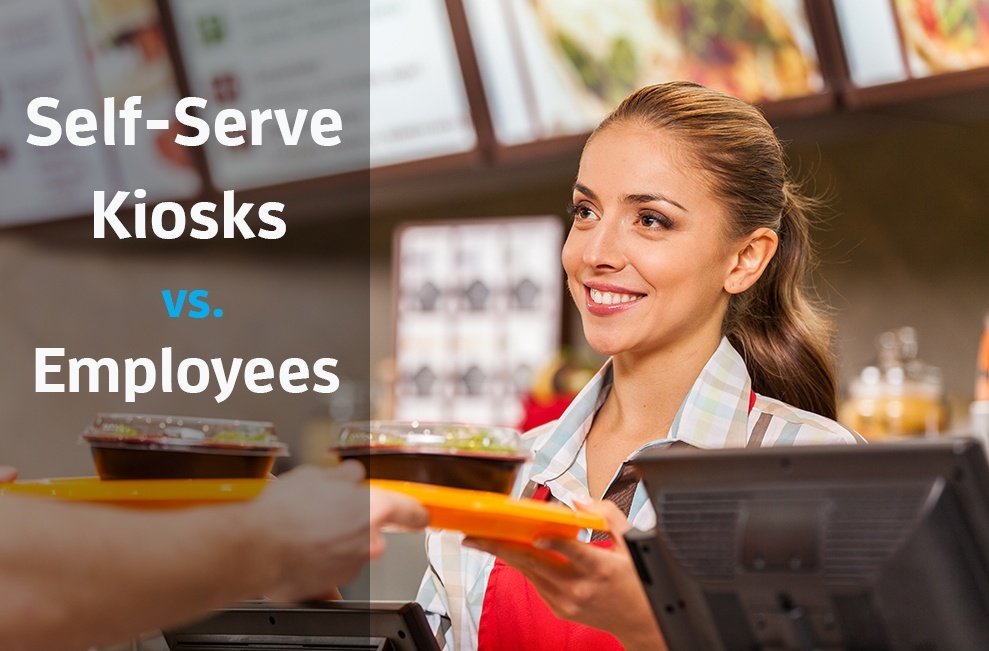
As technology grows and the sophistication of computers improves, there is a fear that creeps up in employees.
There is the concern that machines are going to take away jobs.
This is especially true for people in the quick service restaurant (QSR) industry who are worried that tools like self-serve kiosks will replace front-counter employees. But, we are happy to report that jobs are safe and digital ordering tools will not replace QSR staff.
The Benefits of Self-Serve Kiosks
With minimum wage laws in going into effect in New York, Los Angeles, Seattle, and San Francisco — which will raise wages to $15/hour over the next three years — people are assuming that QSR are installing self-serve kiosks with plans to replace employees.
But QSR aren’t using digital signage tools to replace employees. They are using the technology to improve customer experience and increase revenues.
And, they were implementing the change before minimum wage increases were part of the conversation.
Back in 2011, McDonald’s started integrated self-serve kiosks into their restaurants, placing kiosks in 840 of their locations in Europe. In an email, a spokesman for McDonald’s Europe explained, “Self-order kiosks are not intended to reduce the number of staff in our restaurants, and overall staff numbers have not reduced in the restaurants where they have been installed,” the spokesman said.
“In fact, we expect overall staff numbers at these restaurants to increase as the business grows,” the spokesman went on.
McDonald’s and other chains like Wendy’s, Panera, and Jack in the Box are integrating digital self-service kiosks for reasons other than decreasing human resource needs. They are adding kiosks to improve the customer experience and boost sales for a few reasons.
Kiosks Cater to Complex Orders — Customers with special requests can use kiosks to easily customize their orders. They have more power over the ingredients used in their food. Plus, picky customers don’t have to feel embarrassed about placing a complicated order.
Kiosks Provide Order Accuracy — When customers have special requests and relay their wants to service-counter employees, miscommunication can happen. When customers place special orders on their own, orders are typically more accurate to the customer’s requests.
Kiosks Deliver Extra Nutrition & Ingredient Information — With dietary restrictions and a growing concern over the nutritional content of food, customers often want to know more about the food they are eating. Kiosks make that information available by enabling customers to gather more details about each menu item.
Kiosks Are Visually Driven — Visuals trigger and direct decision-making processes. Seeing photos of food can even make customers change their order. With kiosks, images guide food purchases and can lead customers to higher sales per order.
Kiosks Promote Upsells — QSR typically offer a combo or upsell option for their menu items. With kiosks, instead of a front-counter employee asking, “Do you want fries with that?” self-serve kiosks can prompt photos of upsell opportunities and use visual cues to get customers to add on side menu options and drinks.
Kiosks Break Language Barriers — In locations where guests often speak different languages, kiosks can break the barrier by offering menus in different languages. This is especially beneficial to restaurants located in tourist areas.
Customers Want Self-serve Kiosks — A hospitality industry survey found that more than half of respondents would prefer to visit a restaurant or hotel that offered self-service technology for ordering food or checking out of the property. Customers, particularly younger customers, prefer ordering through a kiosk than counter-service.
Self-service kiosks support staff, improve customer experience, and have even been proven to boost sales and require additional staff to support the restaurant’s demand.
“We actually do not take any labor out of the restaurant,” said Michael Verdeska, interim-CIO and division vice president of Jack in the Box regarding the restaurants use of interactive ordering screens.
“We have actually increased the throughput of restaurants by having kiosks there, so managers actually end up getting more labor,” he said. Kiosks have boosted their businesses actually requiring them to hire additional staff.
The Future of Self-Serve Kiosks
As leading quick-service restaurants roll out their self-service kiosk plans, it’s likely that the trend will catch on quickly.
Brands will begin implementing the technology and also use it in other ways like Panera did in 2014 when they launched Panera 2.0. The plan successfully launched in-store ordering kiosks in select stores as well a mobile ordering app.
Wendy’s is also on track to increase their self-serve kiosks use. Their senior director of corporate communications, Bob Bertin expressed the brand’s interest in kiosks, “We are always looking for opportunities to enhance our customers’ restaurant experience and technology is helping us do that in ways that would have not been possible a few years ago from mobile ordering and pay[ment] to self-service kiosks.”
While Bertin is excited about the possibility of improving customer experience, it’s important to note that he has expressed interested in using the tools to also manage human resource expenses.
“We’re also exploring greater use of technology to help mitigate rising labor and other costs,” Bertin added to his statement regarding kiosk implementation.
But industry experts believe it remains unlikely that the technology will ever replace or substantially decrease the number of employees a restaurant needs to operate.
According to Rahi Roshandel, vice president of hardware engineering and product management at PAR, a point-of-sale solutions company, “In a QSR environment, it would be not right to think [the kiosk] is going to replace employees.”
Smart and successful restaurants will always put customers first, and that means having staff that can support guest in person, provide excellent customer experiences, and keep the human connection in the food industry.
Interested in learning more about self-serve kiosks, interactive screens, and the future of digital signage in commercial locations?
Get our free ebook, “Everything You Need to Know About Digital Signage” to get a complete look at the trends and possibilities of this interactive technology.